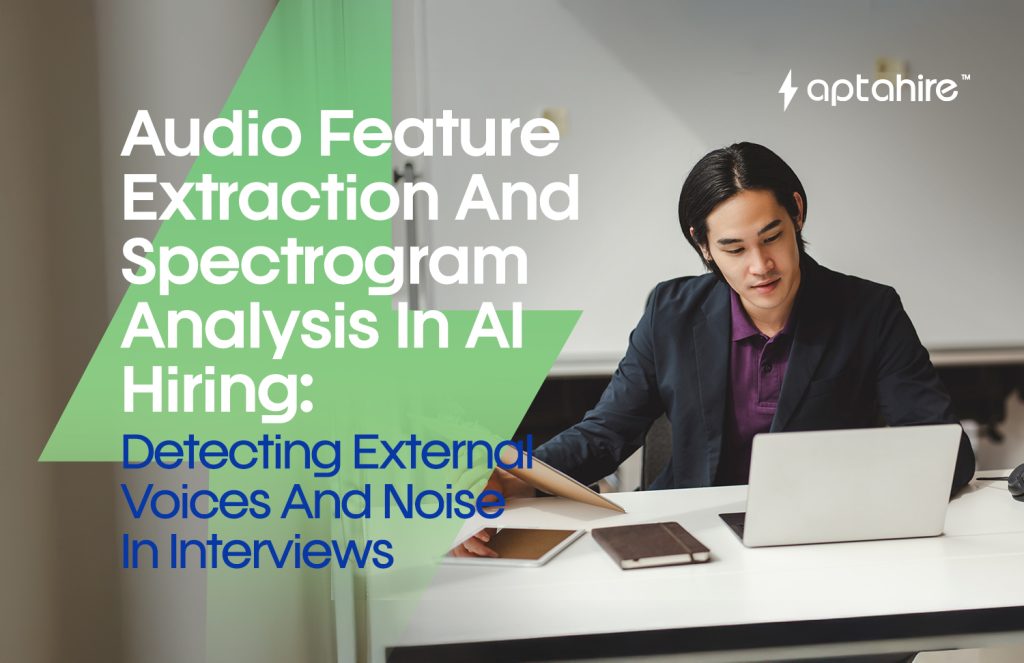Audio Feature Extraction and Spectrogram Analysis in AI Hiring: Detecting External Voices and Noise in Interviews

The New Hiring Reality: More Digital, More Vulnerable
We’re living in an age where remote work isn’t just a trend, it’s a default. From Silicon Valley startups to global enterprises, virtual interviews have become the norm. In fact, according to a 2024 report by Indeed, over 82% of mid-to-large-sized organizations now conduct at least one round of interviews virtually.
Virtual interviews bring accessibility, flexibility, and cost savings. But they also open doors to challenges we’ve never had to face in in-person interviews, like external coaching, answer look-ups, and whispered suggestions from someone sitting just out of frame.
Visual monitoring helps to an extent, AI watches your eyes, gestures, and posture. But what about what’s not visible? What if a candidate is being prompted via audio, softly, subtly, just outside camera view?
That’s where audio feature extraction and spectrogram analysis come into play, allowing AI systems to listen, interpret, and analyze sound like never before.
Let’s dive deep into how these techniques are safeguarding virtual hiring.
What Is Audio Feature Extraction?
Before AI can analyze sound, it needs to translate it into data.
Audio feature extraction is that process, transforming raw audio signals into numerical patterns that represent:
- Frequency (pitch)
- Amplitude (loudness)
- Duration
- Tone
- Speaker characteristics
These extracted features are then used by AI to:
- Detect who is speaking
- Identify what kind of sound is occurring
- Understand patterns and anomalies
Some of the most commonly used features include:
| Feature Type | Description |
| MFCC (Mel Frequency Cepstral Coefficients) | Mimics human ear perception. Useful for voice identity and speech emotion. |
| Chroma Features | Captures pitch classes. Useful for musical or tonal analysis. |
| Spectral Centroid | Indicates brightness of a sound (higher values = sharper sounds). |
| Zero-Crossing Rate | Tracks how often the signal changes from positive to negative, often used to detect sudden noises or sharp sounds. |
| Energy Entropy | Measures how unpredictable a sound is, good for identifying noise bursts or interruptions. |
What is Spectrogram Analysis?
A spectrogram is a way to visualize sound, it’s what your voice “looks” like to AI.
Imagine a heat map:
- X-axis = Time
- Y-axis = Frequency
- Color intensity = Volume (Amplitude)
This allows AI to see patterns, detect changes, and isolate elements such as:
- Background whispers
- Overlapping speech
- Sudden noise spikes (e.g., a phone notification, door knock, typing)
- Non-human sounds (digital voices, audio prompts)
Think of it like a fingerprint for every second of audio. If a second voice enters the spectrogram, even faintly, AI will see it, even if the human interviewer doesn’t hear it clearly.
How AI Uses These Techniques in Virtual Hiring
Let’s explore the workflow of AI-powered audio analysis in the context of a virtual interview:
Step 1: Voice Activity Detection (VAD)
AI determines when speech is happening and when there are silent periods. This baseline is crucial for comparing expected vs. unexpected audio input.
Expected speech: Candidate answering a question
Unexpected: Random voice whispering during candidate’s pause
Step 2: Speaker Diarization
“Who spoke when?” That’s the question diarization answers. The AI segments audio by speaker, creating separate profiles based on:
- Pitch
- Speech rhythm
- MFCC patterns
This helps detect:
- Two different people speaking (e.g., a coach and the candidate)
- Switches between speakers
- Voice changes from natural to robotic (in case of text-to-speech usage)
Step 3: Spectrogram Mapping
The audio is then visualized into a spectrogram, and deep learning models like CNNs (Convolutional Neural Networks) are used to:
- Detect frequency spikes (e.g., a keyboard click or notification)
- Identify non-speech elements (like rustling papers or typing)
- Highlight audio anomalies across time segments
Example:
A whisper at 1.2 kHz suddenly appears during a coding question, lasting 3.2 seconds, and disappears. It doesn’t match the candidate’s voice profile.
Step 4: Contextual Interpretation
AI doesn’t just flag anomalies. It correlates them with:
- Candidate’s speech timing
- Response content
- Prior behavioral patterns
If a candidate hesitates, glances down, and a background voice is detected just before the answer, the AI creates a confidence score that the response may have been externally influenced.
Stats & Real-World Impact
A joint research project by Stanford University and HireVue AI (2024) analyzed over 20,000 virtual interviews. The findings were eye-opening:
| Audio Event Detected | Frequency | Correlation with Higher Answer Accuracy |
| Whispering/low-volume voice | 12.4% | +19% accuracy improvement post event |
| Unusual keyboard sound | 17.1% | +13% spike in technical response quality |
| Voice mismatch (robotic input) | 3.6% | +22% score lift on objective questions |
In other words, audio anomalies were often linked with suspiciously better answers, reinforcing the importance of spectrogram-based monitoring.
Real-Life Example: The Two-Second Whisper
A candidate in a virtual panel interview gave detailed answers to highly technical questions. But AI flagged a pattern: just before each answer, a faint voice appeared for two seconds, too low for human ears, but visible on the spectrogram.
The voice’s MFCC pattern didn’t match the candidate’s. Diarization confirmed it was a second person. Upon confrontation, the candidate admitted someone was feeding them answers via a Bluetooth earpiece.
Is This Ethical? What About Privacy?
That’s a valid concern. Here’s the rulebook ethical AI platforms follow:
| Principle | Practice |
| Transparency | Candidates are informed their audio will be monitored and analyzed. |
| Consent | Recording and analysis proceed only after explicit acceptance. |
| Bias Mitigation | AI is trained on diverse voices, accents, and backgrounds. |
| Human-in-the-Loop | AI doesn’t make final decisions, recruiters do, based on reports. |
In fact, according to Glassdoor’s 2023 Candidate Sentiment Report, 74% of job seekers support AI monitoring if it helps ensure fairness and eliminates cheating.
Benefits for Employers and Recruiters
| Benefit | What It Does |
| Ensures Fair Play | Detects coaching, recordings, and scripted answers |
| Captures Natural Language Flow | Tracks how fluently and confidently candidates respond |
| Filters Disruptive Noise | Flags environmental issues that affect candidate focus |
| Enhances Data-Driven Decisions | Audio scores support or challenge subjective judgments |
| Saves Time | Alerts recruiters only for interviews that need review |
Limitations and Considerations
As powerful as it is, audio analysis has its boundaries:
- False positives can occur with loud background environments
- Heavy accents might be misunderstood by voice recognition engines
- Echoes and lag in poor-quality microphones may distort spectrogram output
To counteract this, platforms include:
- Manual reviewer feedback loops
- Adjustable thresholds for sensitivity
- Audio quality normalization algorithms
Final Thoughts: What You Hear Can Reveal What You Can’t See
In virtual interviews, sound is often the only invisible witness. It catches the whispers, the hesitations, the distractions, all the things that video may miss.
When combined with ethical AI practices, audio feature extraction and spectrogram analysis become not just tools for flagging dishonesty, but for elevating authenticity, focus, and fairness.
After all, interviews are more than a set of answers. They’re a performance, a conversation, and a trust-based interaction. Ensuring that the voice you hear is truly the candidate’s, uncoached, unscripted, and unprompted, is the key to building a transparent hiring future.
TL;DR
AI hiring tools now use audio feature extraction and spectrogram analysis to detect whispers, background voices, and noise anomalies during virtual interviews. These techniques help employers ensure that candidate responses are genuine, free from coaching, and delivered in a distraction-free environment, while still respecting privacy and consent.
FAQs
1. What is audio feature extraction, and how is it used in AI hiring?
Audio feature extraction is the process of converting raw audio into quantifiable data points such as pitch, frequency, tone, energy, and rhythm. In AI hiring, these features help systems detect speaking patterns, identify multiple speakers, measure vocal confidence, and uncover subtle indicators like whispering or scripted responses, ensuring the authenticity of candidate communication.
2. What is a spectrogram, and why is it important during interviews?
A spectrogram is a visual representation of sound, mapping time (x-axis), frequency (y-axis), and volume (color intensity). It allows AI to “see” and analyze audio, helping detect faint voices, background noises, or overlapping speech that might indicate external help or distractions during a virtual interview.
3. Can AI really detect if someone else is speaking in the background?
Yes. Through techniques like speaker diarization and voiceprint analysis, AI can identify when multiple speakers are present, even if one is whispering or faintly audible. These models use variations in pitch, tone, and frequency to separate voices and flag any external coaching or interference.
4. Will the AI penalize candidates for accidental background noise (like a dog barking or a car horn)?
Not automatically. Ethical AI systems are designed to differentiate between random environmental sounds and intentional voice-based interference. Sudden non-speech sounds may be noted but are not used to disqualify candidates unless they affect the interview’s integrity or response quality.
5. What happens if the AI wrongly flags a noise as suspicious?
In responsible platforms, AI doesn’t make rejection decisions, it only flags anomalies for human review. Recruiters can see timestamps, listen to flagged audio, and assess the context. Candidates also often have an opportunity to explain unusual events, ensuring fair evaluation.
6. How is candidate privacy protected during audio monitoring?
Transparency and consent are key. Candidates are always informed in advance that their audio and video will be monitored and analyzed for quality and authenticity. The data is processed securely, used solely for interview evaluation, and stored according to data protection regulations like GDPR or local labor laws.
7. Can this technology detect pre-recorded or AI-generated (text-to-speech) answers?
Yes. AI hiring tools use acoustic fingerprinting and prosodic feature analysis to detect inconsistencies in speech flow, robotic tone, and mismatches between lip movement and audio. If a candidate uses a pre-recorded or AI-generated voice, the system will likely identify it through unnatural speech patterns and rhythm.
8. How can candidates avoid being mistakenly flagged for audio issues?
Candidates should:
- Use a quiet, echo-free room
- Use headphones with a noise-canceling mic
- Inform household members to avoid interrupting
- Turn off background devices like TVs, smart speakers, or alarms
- Run a test call before the interview
These steps help minimize false flags and create a distraction-free interview environment.



